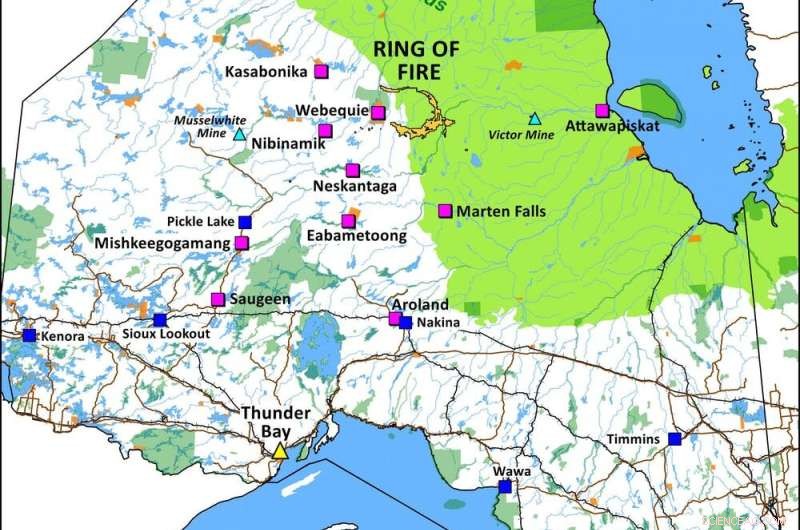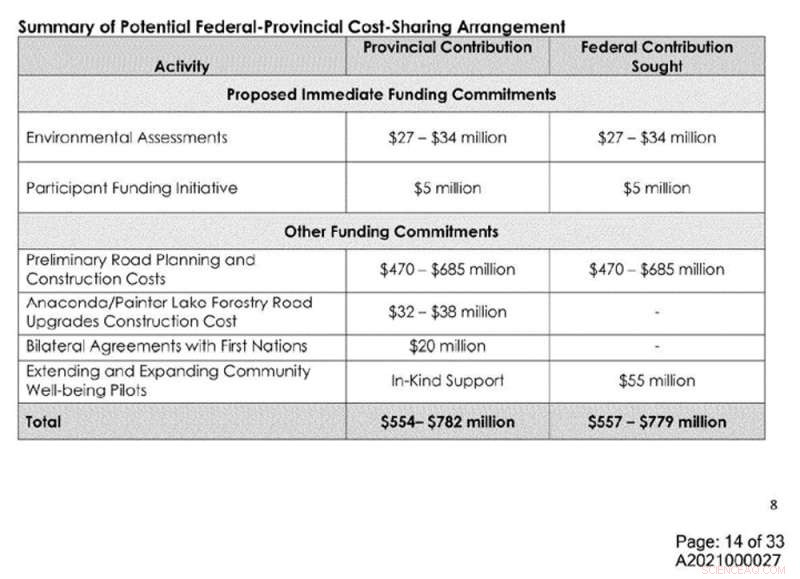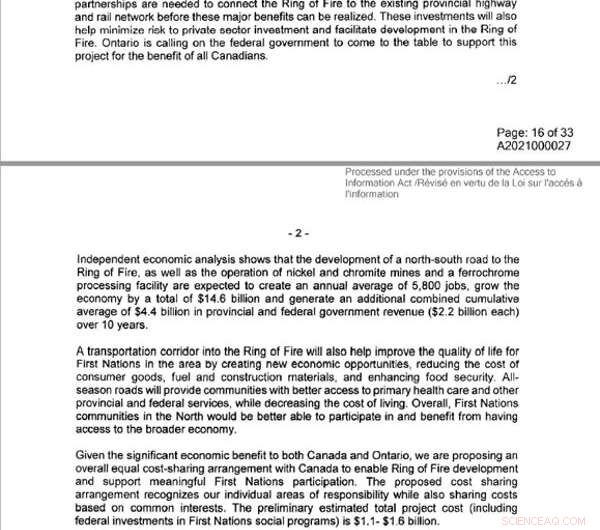
En karta över Ring of Fire-regionen. Kredit:Noront Resources Ltd.
Noront Resources Ltd. – företaget i hjärtat av Ontarios svåra gruvutveckling Ring of Fire – skapar återigen rubriker som föremål för konkurrerande företagsuppköpserbjudanden från gruvjätten BHP Billiton och det australiensiska privata investeringsföretaget Wyloo Metals.
Budkriget har fått Noronts aktiekurs att hoppa 235 procent till den högsta nivån sedan 2011.
Vid sidan av aktiekurserna har också ursprungsbefolkningens opposition ökat, vilket har väckt betydande frågor om lönsamheten för den föreslagna gruvdriften och värdet av Noronts tillgångar.
Neskantaga First Nation och Mushkegowuk Council, som representerar sju drabbade First Nations, ifrågasätter öppet omfattningen och takten i minutvecklingen i sina territorier. De är i sällskap med andra First Nations i hela regionen som i flera år har hävdat sin politiska och territoriella auktoritet inför Noronts föreslagna planer.
Att hävda jurisdiktion
Ursprungsjurisdiktion och dess förnekande av myndigheterna har haft en enorm inverkan på Noronts förmögenheter. Utvecklingen av företagets flaggskeppsgruva har avstannat sedan 2011, liksom den 300 kilometer långa industrivägen hela säsongen – kallad "vägen till ingenstans" på grund av dess tvivelaktiga ekonomiska utsikter – som behövs för att komma åt den avlägsna gruvregionen.
Detta beror på att regionens första nationer konsekvent har krävt att Ontario erkänner deras jurisdiktion över deras land och territorier. Matawa-nationerna, inklusive Neskantaga, tvingade till en början provinsen att förhandla fram en gemensam regional strategi för beslutsfattande.
Det så kallade regionala ramavtalet stoppade provinsen från att ensidigt sanktionera utveckling på ursprungsbefolkningens mark, men upplöstes slutligen av provinsen 2019.
Ursprungsmyndigheter har sedan dess fortsatt att hävda sin jurisdiktion i regionen. Nu senast insisterar en koalition av tre First Nations (Attawapiskat, Fort Albany och Neskantaga) på att en nyligen etablerad regional bedömning av de kumulativa effekterna av föreslagna gruvor och vägutbyggnader leds av ursprungsbefolkningen.
Under hela denna period har Noront-aktien rasat från nästan 2 USD i början av 2010 till mindre än 20 cent sedan 2019. Företagets skuld har ökat med minst 100 miljoner USD sedan 2013 till 299 miljoner USD den 31 december 2020 och dess utestående lån stå på 51,4 miljoner dollar.
Trots ökande bevis för att värdet av företaget och dess tillgångar kräver ursprungsbefolkningens samtycke, har federala och provinsregeringar fortsatt att satsa hundratals miljoner dollar på gruvutveckling i Ring of Fire i form av prospekteringsfinansiering och infrastrukturstöd.

En skärmdump av interna dokument som erhållits via en begäran om informationsfrihet visar omfattningen av provinsiella och federala investeringar i den föreslagna Ring of Fire-utvecklingen. (Författare tillhandahålls)
Miljoner för utforskning
När godkännandeprocesserna har dragit ut på tiden och sedan avstannat, har Noront – med stöd av federala och provinsiella statskassor – försökt skapa värde genom att öka sina tillgångar och utöka sitt prospekteringsprogram.
Sedan december 2008 visar företagets lagar att de federala och Ontarios regeringar har subventionerat Noronts Ring of Fire-utforskningsprogram till nästan 45 miljoner dollar genom en skattebaserad mekanism som kallas genomflödesfinansiering.
That mechanism allows firms to raise exploration funds from investors and return tax credits to them.
Additional federal and provincial refundable tax credits are also available to flow-through investors, resulting in the transfer of millions of dollars—money that would have otherwise been tax revenue—to Noront's exploration of the Ring of Fire. According to the company's aforementioned regulatory filings, Noront has raised more than $75 million of flow-through financing since 2008 for Ring of Fire properties.
This flow of government money reveals a system of economic relationships described by the Yellowhead Institute, a First Nations-led research center, as colonial and predatory.
Amid Indigenous demands to determine and control the pace of development in their territories and to create the institutions required to do so, this flow of money also raises serious concerns about the financial realities of the Ring of Fire project.
Circumventing Indigenous jurisdiction
While the province once estimated the cost of implementing the doomed framework agreement to be slightly over $20 million, the cost of circumventing Indigenous jurisdiction is much higher.
Since tearing up the agreement in 2019 in an attempt to speed up development, Ontario has entered into bilateral funding agreements worth $20 million with two First Nations currently serving as proponents of the all-season road.
According to documents obtained though an Access to Information request, it's also currently negotiating a planning agreement worth $38 million with another First Nation.

Internal documents obtained via a Freedom of Information request details Ontario’s proposal of a cost-share arrangement with Ottawa on the all-season road in the Ring of Fire. (Author provided), Author provided
These same documents reveal the federal government spent approximately $11 million annually since 2016 to fund so-called community well-being projects in five Matawa communities. These are programs purportedly aimed at improving "community readiness" for mining operations in the Ring of Fire.
If Ontario has its way, this funding will be renewed at a total of $55 million over five years. Between 2010 and 2015, Indigenous and Northern Affairs Canada contributed nearly $16 million through the strategic partnership initiative to "support First Nations mining readiness activities" in the area, an investment topped up by a few million in 2016.
It also contributed $255 million over two years to a First Nations fund partially earmarked to support regional infrastructure in the Ring of Fire and intended to encourage compliance with mining projects.
A 2019 intergovernmental memo—also obtained via the Freedom of Information request—shows the federal government also offered to "explore options to advance Ring of Fire projects" using money that was designated for well-being projects in Indigenous communities.
There's also the matter of the $1.6 billion all-season road. Ontario has promised to fund the road through the homelands of multiple First Nations, most recently through a proposed cost-share arrangement with Ottawa.
Debt, debt and more debt
Noront has consistently under-represented to investors, and now to corporate suitors, the legal and financial liabilities associated with Indigenous jurisdiction—and there are many.
Regardless of who successfully bids for the company, opposition to the Ring of Fire project is only likely to increase unless First Nations are empowered to exercise real control over the decisions that will impact them. This raises the specter of litigation, Indigenous land defense actions—and more debt.
According to the internal documents, the federal and provincial government are expecting to earn $4.4 billion in combined tax revenues during the first 10 years of the proposed mine's operation. But if they add up the amount of money they've already paid to defy and circumvent Indigenous jurisdiction, and the financial costs associated with continuing to do so, that $4.4 billion will soon be exhausted.
It is entirely likely that any profits related to this enterprise have already been spent. The question that remains is who will be left holding the debt?